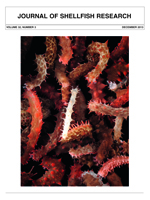Several restored oyster (Crassostrea virginica Gmelin) reefs in Pamlico Sound, North Carolina, have experienced recent population crashes, potentially caused in part by clionid boring sponge infestation of the marl rock (a calcium carbonatemud composite material) commonly used as a reef substrate and of the shells of oysters that colonize the marl reef foundation. The composition and porosity of marl may make it vulnerable to infestation by carbonate bioeroders, particularly clionid sponges. The objective of this study was to quantify the effects of carbonate (CaCO3; oyster shell, marl) versus noncarbonate (non-CaCO3; granite, concrete) reef-building substrates on C. virginica demographic rates, including oyster density and oyster growth, on experimental reefs constructed along the salinity gradients of two estuaries in coastal North Carolina. There were no differences in oyster density among substrate types through the first 6 mo of reef sampling, although at 12 mo after reef construction, differences in density among substrates had emerged. Sites in high-salinity areas had much greater oyster recruitment than up-estuary, lower salinity locations. Early-life growth (<6 mo) of oysters was assessed for recruits to experimental reefs, with few differences seen in oyster mean valve length or growth rate on different substrate types. These results support consideration of non-CaCO3 materials, particularly concrete, for future oyster reef restoration, especially in high-salinity areas where the boring sponge Cliona is abundant, because both oyster density and growth were similar on oyster shell and concrete substrates as long as 1 y after reef construction.
How to translate text using browser tools
1 April 2014
Effects of Substrate Type on Demographic Rates of Eastern Oyster (Crassostrea virginica)
Robert P. Dunn,
David B. Eggleston,
Niels Lindquist
ACCESS THE FULL ARTICLE

Journal of Shellfish Research
Vol. 33 • No. 1
April 2014
Vol. 33 • No. 1
April 2014
bioerosion
clionid sponge
Crassostrea virginica
growth
oyster
recruitment
restoration




